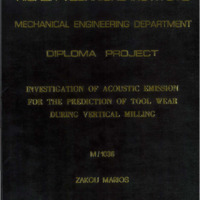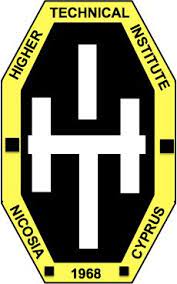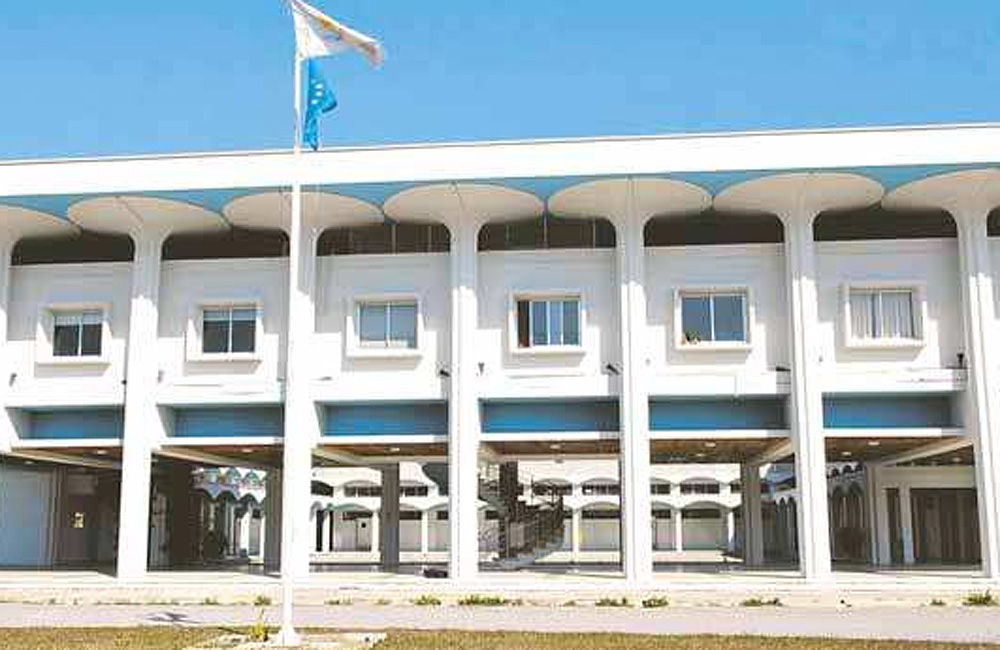Investigation of acoustic emission for the prediction of tool wear during vertical milling
- Τίτλος
- Investigation of acoustic emission for the prediction of tool wear during vertical milling
- Θέμα
- Acoustic emission
- Milling (Metal-work)
- Milling-machines--Vibration
- Δημιουργός
-
Zakou, Marios Z.
- Πηγή
- Higher Technical Institute
-
Το πλήρες κείμενο είναι διαθέσιμο από το Υπουργείο Ενέργειας, Εμπορίου Βιομηχανίας και Τουρισμού.
- Εκδότης
- Library of Cyprus University of Technology
- Ημερομηνία
- 2007
- Συνεισφέρων
- Messaritis, Vassilios
- Δικαιώματα
- Απαγορεύεται η δημοσίευση ή αναπαραγωγή, ηλεκτρονική ή άλλη χωρίς τη γραπτή συγκατάθεση του δημιουργού και κάτοχου των πνευματικών δικαιωμάτων.
- Μορφή
- Γλώσσα
- en
- Τύπος
- text
- Αναγνωριστικό
- MED0499
- Σύνοψη
-
The purpose of this work was the investigation of Acoustic Emission (AE) as a method for predicting tool wear during vertical milling. This work was born near last December. To tell you the truth if someone before December came to ask the author what Acoustic Emission is all about his answer would surely be ... 'WHAT?" The reason for choosing to study the specific subject was the need of meeting something new and the specific work was offered for this purpose.
This work has started by first starting to know what Condition Monitoring (CM) and furthermore what Acoustic Emission (AE) is all about. After this preliminary research the next step was to get "In-Line", meaning that the next step was to start the preliminary work in order for the various tests for investigating the purpose of this work to begin.
Tests could not start immediately due to the fact that some preliminary testing in order to establish the appropriate equipment which would be used during the work should be carried out. This preliminary testing turned out to be the most difficult part of the whole work due to the fact that several problems with the initial equipment and instrumentation had occurred. At the beginning problems with the oscilloscope had occurred due to the fact that the specific oscilloscope GDS-806C was not able to provide with data for future analysis but only with jpeg and bitmap images of frozen screen, so for this reason the use of the Pico digital oscilloscope has been decided for the purposes of the specific work. Another problem which has occurred of vital importance was the fact that the preamplifier AEP3 which was first used was providing no amplification to the generated AE signal, so the AEP4-1 S preamplifier was adopted.
When the proper equipment has been chosen, various tests have taken place. The first part of the experiment included tests which included the variation of the cutting conditions during machining for a 60 mm face cutter and the second part had as purpose the investigation of the variation of the AE generated during cutting with sharp and worn tools and for this purpose cutters of 14 and 18 mm of the slot drill type sharp and worn have been used.
As far as the first part of the experiment is concerned, the one with the 60 mm face cutter, tests of examining the AE generated during varying the depth of cut, feed rate, and cutting speed were conducted.
In each test, two of the above said cutting conditions were kept steady while the third was varied. After capturing the AE signals generated during these tests several conclusions have been extracted and a quite detailed discussion is presented in chapter 8 for each case.
As far as the second part of the experiment is concerned, the results were quite clear from the point of view that during the examination of the signals captured, the difference in the RMS background level of the AE generated during cutting with sharp tools and the AE generated during cutting with worn tools has presented, a difference which could be translated that it is due to the tool wear formation. Although in the specific tests the RMS background level was quite low this could not stop the extraction of the very useful conclusion which states that the AE generated during cutting with sharp and the AE generated during cutting with worn tools presents a difference.
A strong effort has taken place in order to present results in an easy understandable form in order to provide an easiness of comparison with results stated from other researchers. For each test, cutting conditions, RMS background levels of the AE signal generated, and also a typical signal for each case are presented. More signals could not be shown due to lack of space. As far as the conclusions and comments is concerned, for each test separately, a discussion has taken place trying to explain what was possible to be explained.
So, by concluding it must be said that a great amount of work has been done during the last months and several hours were dedicated on this work. One of the most important conclusions of this work was the fact that future work is a "musf. Future work on the subject on which this work is all about, must take place in order to get into further depth and study how the AE generated responds under a larger variety of cutting conditions, tool diameters and workpiece materials. In our belief, a lot of things have been earned from this work and as far as the subject of Acoustic Emission (AE) is concerned, it proved to be a quite interesting subject which must be and will be, further studied in the future.
- Πολυμέσα
-
 MED0499.pdf
MED0499.pdf
Τμήμα του Investigation of acoustic emission for the prediction of tool wear during vertical milling


